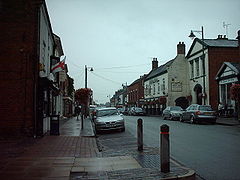Eccleshall
| Eccleshall | |
|---|---|
 Eccleshall |
|
| Eccleshall shown within Staffordshire | |
| Population | 4,651 (2011 census) |
| OS grid reference | SJ832291 |
| District | |
| Shire county | |
| Region | |
| Country | England |
| Sovereign state | United Kingdom |
| Post town | STAFFORD |
| Postcode district | ST21 |
| Dialling code | 01785 |
| Police | Staffordshire |
| Fire | Staffordshire |
| Ambulance | West Midlands |
| EU Parliament | West Midlands |
| UK Parliament | |
Eccleshall is a town in Staffordshire, England. It is located seven miles north west of Stafford, and six miles west of Stone. Eccleshall is twinned with Sancerre in France.
According to the Domesday book, Eccleshall in 1086 was no more than a small village of about one hundred inhabitants. A few fragments of stone at the base of the tower of the present Parish Church of Holy Trinity suggest that a stone church was in existence about this time and the base of a 10th-century cross still stands outside the church. The oldest part of the church, the pillars and arches of the nave, were begun in 1180 while the remainder of the church was completed during the 13th century, with a fine clerestory being added in the 15th century.
Eccleshall became important as a market town for the surrounding area. In 1153 it was granted the right to hold a weekly market. Around the beginning of the 13th century the village had become a town with the granting of ‘Borough’ status and by 1259 had obtained a charter to hold an annual fair at Ascensiontide. By the time of the survey of the Bishop’s estates in 1298 about five hundred people lived in the village, mainly craftsmen or engaged in agriculture.
To the Bishop of Lichfield, Eccleshall was conveniently situated on the main road between the centres of the diocese in Chester, Lichfield and Coventry. Land was reputedly granted to St Chad and in 1200 Bishop Geoffrey de Muschamp was granted by King John a ‘licence to crenellate’ a castle. From then on until the 1860s the site would provide a residence for the Bishops of Lichfield.
However the ruins which exist today are those a later castle built in 1305 by Bishop William Langton, a friend of King Edward I of England and later Chancellor of England. This was the great era of castle building and he built an imposing fortress with four corner towers and a wide moat. Eccleshall castle briefly played a part in the War of the Roses, when it was used as a base for the Lancastrian Queen Margaret of Anjou and her troops before and after her defeat at the Battle of Blore Heath in 1459.
...
Wikipedia

